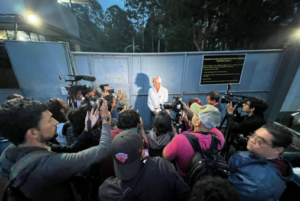In 2024, LatAm Journalism Review (LJR) published more than 250 articles, interviews, and resource lists on journalism and press freedom across the region.
Coverage of violence against journalists, particularly in Mexico, held a significant place in our reporting, as did the rise in repression in Venezuela following the country’s contested presidential elections.
Other cases we followed closely this year included Guatemalan journalist José Rubén Zamora Marroquín, who spent over 813 days in prison before being granted house arrest, and the judicial harassment faced by journalists in Brazil.
As we do every year, each LJR reporter prepared their own retrospective, selecting their most memorable stories and highlighting others written by their colleagues.
We also listed the articles that most captivated our audience and ranked among the most-read pieces of the year.
In my five years reporting for the LatAm Journalism Review, violence against journalists in Mexico has been a constant and heartbreaking reality. Amid this harrowing scenario, the creativity and courage of Mexican journalists have remained constant—they refuse to bow to threats and continually invent new ways to resist those who seek to silence them.
In the report "From the newsroom to the stage," my colleague César López Linares explored how journalists are using theater to connect with audiences and raise awareness about the impact of violence. This initiative deeply moved me because it highlights the potential of art and storytelling to build bridges and envision new possibilities for the world: a world where journalists who hold power accountable are respected and valued as the brave and essential professionals they are.
In Argentina, the situation for journalists is not as dire as in Mexico, but professional organizations and associations have raised alarms about setbacks to press freedom and a rise in violence against journalists. In the report "Online violence silences women journalists in Argentina," I delved into a specific aspect of violence against journalists in the country: attacks targeting women journalists covering abortion rights, femicides, and human rights.
The accounts I read and heard left a profound impression on me. As a woman, journalist, and mother, I couldn’t help but empathize with an Argentine journalist who shared how she received a threat mentioning her child. The perpetrator accomplished the goal: the journalist abandoned her coverage out of fear for her child’s safety. Stories of journalists silenced by digital violence are stark evidence that the virtual is real—and that there are many who seek to silence women who speak out against the violence so many of us face daily. We cannot leave them to face this alone.
Throughout 2024, press freedom in the region took a hit due to numerous attacks, a reality reflected in many of our stories at LJR. Examples include the prolonged imprisonment of journalist José Rubén Zamora in Guatemala (who, despite recently being granted house arrest, already faces serious attempts to return him to prison) and similar efforts targeting journalist Gustavo Gorriti in Peru. There were, however, some glimmers of hope in cases where justice was achieved after more than 40 years. These include the sentencing in Peru for the abduction of journalist Jaime Ayala Sulca and the ongoing trial in El Salvador for the murder of four Dutch journalists.

Guatemalan journalist José Rubén Zamora was released to house arrest on Oct. 19, 2024, after 813 days in prison. (Nelton Rivera/Prensa Comunitaria)
One of the most impactful stories, however, is that of Nicaraguan journalist Fabiola Tercero, who has been missing since police raided her home on July 12. Tercero managed to alert some colleagues about what was happening, but the country’s authorities have refused to provide any information about her situation. Her case deserves the full attention of the international community and stronger demands on Daniel Ortega’s administration to disclose information about Tercero. Press freedom organizations consider her case a forced disappearance.
Speaking of impactful cases, I encourage you to read the article by my colleague Carolina de Assis, which details how two journalists in Brazil identified 63 political candidates who were wanted by the country’s justice system. Prompted by a reader’s comment and through data journalism, the reporters led an investigation that resulted in the arrest of 36 candidates in Brazil's municipal elections.
This year, freedom of expression and journalism in Venezuela, my home country, faced unprecedented threats. At LatAm Journalism Review (LJR), we rose to the challenge, closely following events before and after Nicolás Maduro declared himself the winner of the presidential elections in late July, amid controversy and without the official results being published.
Through my reporting, I documented how digital media outlets prepared in advance of Venezuela’s election to overcome repression and disinformation; how journalists covering post-election protests outside of the big cities were more vulnerable to physical attacks; how a group of anonymous reporters protected themselves by presenting their fact finding through AI-generated avatars; how authorities detained female journalists, and how authorities detained and revoked passports from some journalists in the post-election crackdowns.
These articles summarize how, since the elections, authorities have detained a dozen journalists, shut down three media outlets, revoked the passports of about 20 journalists, and blocked several social media platforms and websites. These actions have forced many press workers to flee the country or seek alternatives to continue informing the public.
I also want to highlight the work of my colleague César López Linares on violence against journalists in Mexico. In his piece “How press freedom in Mexico eroded during López Obrador’s presidency,” César provides a clear and concise summary of press freedom during López Obrador’s administration, which was marked by an alarming rise in attacks on journalists and a controversial media relations strategy.
As journalists, we are taught to effectively use language—our primary tool of the trade. But what happens when that principle clashes with one of the profession’s core duties: to report reality as it is? This dilemma inspired me to write the article we published in February, “Beyond language, experts say empathy, precision and respect are key in coverage of nonbinary people.”
Experts in language and journalists who have covered topics related to non-binary individuals shared their views on how some media outlets’ refusal to use inclusive language contributes to the invisibilization and revictimization of this population. The article also explained that using non-binary language in news reporting does not violate the rules of Spanish. On the contrary, it aligns with journalism’s commitment to accuracy, respect for plurality, and representation of diverse experiences.
From my colleagues, I’d like to highlight Katherine Pennacchio’s article “Digital media in Venezuela collaborate to overcome disinformation and press restrictions ahead of presidential elections.” The piece demonstrated how collaborative initiatives between media outlets help tackle the challenges of covering electoral processes in authoritarian contexts.
Katherine’s article detailed strategies that became particularly relevant after the elections, when the outlook for the press grew even darker, characterized by arbitrary detentions, widespread self-censorship, and an increasingly hostile environment for journalism.

Claudia Sheinbaum, the new president-elect of Mexico, in a photo of February 2020, when she was Mexico's city mayor
(Photo: Gabriela Malagón/ Secretaría de Cultura de la Ciudad de México)
Among the articles I published in LJR in 2024, I consider “Mexico’s next president promised to protect the country’s journalists. What can she do?” the most important. The situation Mexican journalists face is insane, with deaths accumulating over the years with no significant change.
None of this is inevitable. It all depends on political decisions, on whether the government chooses to prioritize journalists’ safety. My article offers a roadmap of concrete actions for Claudia Sheinbaum to follow if she intends to protect them. Unfortunately, this is not happening: in her first 65 days in office, three journalists have been murdered.
Secondly, I’d like to highlight three articles about judicial harassment in Brazil: “Journalists who criticize Brazilian governor face investigations and legal proceedings;” “In Brazil, politicians are bombarding journalists with lawsuits over unfavorable coverage;” and “Supreme Court of Brazil sets precedent to combat judicial harassment of journalists.”
Together, these pieces show how widespread judicial harassment against journalists has become in Brazil and how powerful political and economic actors use it to silence critics. They also discuss how the judiciary is responding to these issues—taking concrete steps, though still insufficient.
Finally, I want to highlight the interview “There is a structural affinity between media and populist communication,” with political scientist Paula Diehl. This analysis touches on deep questions about the press that merit reflection from all journalists.
From my colleagues’ work, I must commend the brilliant coverage by Silvia Higuera on the imprisonment of Guatemalan journalist José Rubén Zamora. The case of Zamora, who was in prison for 813 days, is one of the most grotesque examples of censorship today. He is currently under house arrest, which is itself an injustice, and it remains uncertain how long his ordeal will continue.
Events journalists from Latin America should not miss in 2024
10 innovative journalism projects that made an impact in Latin America in 2023
15 concepts for understanding AI in journalism – and their applications in newsrooms
Site blocking and impersonation threaten media in Venezuela, according to IPYS report
Projects use generative AI to bring Indigenous languages to the news in Peru
Cuestión Pública of Colombia creates AI tool to improve daily coverage with investigative journalism
Journalists in Brazil reflect on how block of X/Twitter will affect their work